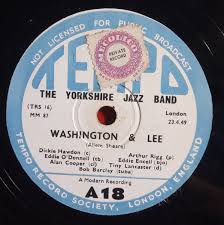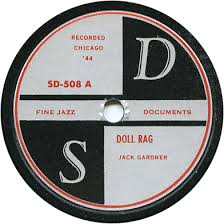
Daily Dose Of Jazz…
Richard Hawdon was born in Leeds, England on August 27, 1927 and first studied cello before moving to trumpet in his mid-teens. After a stint with the Yorkshire Jazz Band he relocated to London, England in 1951, signing on with Chris Barber’s famed New Orleans Jazz Band.
Hawdon replaced trumpeter Ken Colyer in the Christie Brothers Stompers in 1952, remaining with the group for close to two years. While his Louis Armstrong-inspired approach earned favor among traditional jazz purists, he developed a modernist sensibility influenced by Clifford Brown.
Bop and progressive jazz followed in 1954 as a member of Don Rendell’s group in addition to a stint as trumpeter and arranger with Tubby Hayes. He joined his first big band in mid-1956 with Basil and Ivor Kirchin and the next year he joined John Dankworth in 1957. This would be his longest and most rewarding career collaboration.
Beyond recordings with Dankworth, the group performed with Louis Armstrong, teamed with the Duke Ellington Orchestra, he wrote and arranged a number of Dankworth staples including Cool Kate and One for Janet. Hawdon went on to freelance with bandleaders Sid Phillips, Harry Gold, Oscar Rabin, Terry Lightfoot, and backed singers Tony Bennett and Eartha Kitt during a stint with the house band at the London cabaret Talk of the Town.
On the eve of the demise of jazz as the leading music of the era, Dick relocated to Yorkshire, England in 1967 and led the Batley Variety Club’s house band. A year later, he developed a jazz course at the new City of Leeds College of Music, and became head of the school’s Light Music Department in 1972. Hawdon also led his own jazz quintet throughout the 1980s, and after retiring from academia in 1993 he turned his attention to the bass, playing in a series of local groups.
Trumpeter and bassist Dick Hawdon died June 24, 2009.
More Posts: bandleader,bass,history,instrumental,jazz,music,trumpet

Daily Dose Of Jazz…
Jack Payne was born John Wesley Vivian Payne on August 22, 1899 in Leamington Spa, Warwickshire, England. He is the only son of a music publisher’s warehouse manager and it wasn’t until he was serving in the Royal Flying Corps that he played the piano in amateur dance bands. Towards the end of World War I, he led dance bands for the troops and was part of a voluntary group The Allies Concert Party that performed to wounded soldiers convalescing around Birmingham.
He played with visiting American jazz bands at the Birmingham Palais during the early 1920s, including the Southern Rag-a-Jazz Orchestra in 1922, before moving to London in 1925. He played in a ten-piece band which became the house band at London’s Hotel Cecil. Three years later Payne became the BBC Director of Dance Music and the leader of the BBC’s first official dance band.
After leaving the BBC in 1932 he returned to playing hotel venues and switched labels to Imperial, followed by Rex from 1934. Payne took his band on nationwide tours and made a couple of films, composed and published waltzes, and recorded jazz working with Garland Wilson.
>Returning to the post of Director of Dance Music at the BBC until 1946. Bandleader and composer Jack Payne, who authored two autobiographies, died in Tonbridge, Kent, England on December 4,1969, aged 70.
More Posts: author,bandleader,composer,history,instrumental,jazz,music

Daily Dose Of Jazz…
Terence Michael “Terry” Clarke was born August 20, 1944 in Vancouver, Canada. He studied percussion with Jim Blackley and played with Chris Gage and Dave Robbins early in his career. From 1965 to 1967 he toured in a quintet with John Handy, and joined The Fifth Dimension in 1967, remaining until 1969.
In 1970, he moved to Toronto, Canada where he began a longstanding association with Rob McConnell’s group, Boss Brass. He also played with Ed Bickert, Ruby Braff, Jim Galloway, Sonny Greenwich, Jay McShann, Emily Remler, and Frank Rosolino. In 1976, he toured with Jim Hall for the first time and in 1981 did an international tour with Oscar Peterson.
Relocating to New York City in 1985 he played or recorded with Toshiko Akiyoshi, Eddie Daniels, Oliver Jones, Roger Kellaway, Helen Merrill, Ken Peplowski, and Joe Roccisano, among others. He played with the Free Trade ensemble in 1994, a quintet composed of Clarke, Ralph Bowen, Neil Swainson, Renee Rosnes, and Peter Leitch.
Returning to Toronto in 1999, he joined The Rob McConnell Tentet. His 2009 debut album It’s About Time won a Juno Award for Traditional Jazz Album of the Year. Drummer Terry Clarke, who recorded 29 albums as a sideman and was appointed a Member of the Order of Canada in 2002, continues to perform and record.
More Posts: bandleader,drums,history,instrumental,jazz,music

Daily Dose Of Jazz…
Monk Hazel was born Arthur Frank Hazel to a drummer father on August 15, 1903 in Harvey, Louisiana. Early on he played drums with Emmett Hardy, who gave him his first cornet, and then with Stalebread Lacombe. In the 1920s he worked with many bands including the Halfway House Orchestra led by Abbie Brunies, Tony Parenti with whom he recorded in 1928, and Johnny Wiggs.
From the late 1920s to the early 1930s, Hazel led his own Bienville Roof Orchestra which played atop the Bienville Hotel at Lee Circle, and made recordings in 1928 and then spent time in New York playing with Johnny Wiggs, Jack Pettis and with his own group from 1929 to 1931.
Hazel relocated to Hollywood in Los Angeles, California for a period working with Gene Austin but eventually returned to New Orleans, Louisiana performing with Joe Caprano in 1937 and the Lloyd Danton Quintet. He spent 1942-43 in the Army and then worked for a time outside of music.
During his final twenty years, Hazel was once again active in New Orleans, recording with his own band in 1945 and performing with Sharkey Bonano from 1949 to 1952, George Girard, Mike Lala, Santo Pecora and virtually every other important name in New Orleans jazz.
As a leader, Monk recorded four titles in 1928 for Brunswick Records and a full album for Southland Records in 1954; Pete Fountain and Al Hirt were among his sidemen on the latter recording.
Drummer and cornetist Monk Hazel, who occasionally took cornet and mellophone solos, died on March 5, 1968 in New Orleans.
More Posts: bandleader,cornet,drums,history,instrumental,jazz,music

Daily Dose Of Jazz…
Francis Henry “Jumbo Jack” Gardner was born in Joliet, Illinois on August 14, 1903. In the early-1920s he played locally in Denver, Colorado with Doc Becker’s Blue Devils, Boyd Senter’s band and others.
Moving to Chicago, Illinois in 1923, he led his own band in addition to playing with musicians like Wingy Manone, Jean Goldkette, and Gene Austin. He remained in the city through 1937, playing with Jimmy McPartland in 1936.
When he rellcated to New York City he began associations with Sandy Williams’s orchestra and Harry James, but returned to Chicago early in the 1940s, where he led his own group. In 1944, he recorded with Baby Dodds.
He spent much of his later life playing in Dallas, Texas, where he died in 1957. Gardner’s compositions include the song Bye, Bye, Pretty Baby, co-written with George Hamilton.
Pianist Jack Gardner died on November 26, 1957 in Dallas, Texas at the age of 54.


